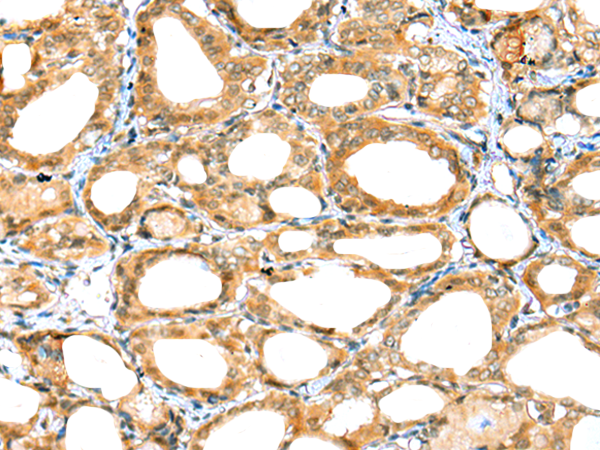
| WB | 咨询技术 | Human,Mouse,Rat |
| IF | 咨询技术 | Human,Mouse,Rat |
| IHC | 1/25-1/100 | Human,Mouse,Rat |
| ICC | 技术咨询 | Human,Mouse,Rat |
| FCM | 咨询技术 | Human,Mouse,Rat |
| Elisa | 1/5000-1/10000 | Human,Mouse,Rat |
| Aliases | COBP |
| Host/Isotype | Rabbit IgG |
| Antibody Type | Primary antibody |
| Storage | Store at 4°C short term. Aliquot and store at -20°C long term. Avoid freeze/thaw cycles. |
| Species Reactivity | Human |
| Immunogen | Fusion protein of human CBWD1 |
| Formulation | Purified antibody in PBS with 0.05% sodium azide and 50% glycerol. |
+ +
以下是3篇涉及CBWD1抗体的参考文献摘要信息,基于该基因相关研究领域整理:
1. **文献名称**: "Characterization of CBWD1 as a novel regulator of neural crest development"
**作者**: Liu Y, et al.
**摘要**: 本研究首次报道CBWD1蛋白在神经嵴细胞迁移中的调控作用,通过构建Cbwd1基因敲除小鼠模型,并使用兔源多克隆CBWD1抗体进行Western blot和免疫组化验证,发现该基因缺失导致颅面部发育异常。抗体特异性经siRNA敲低实验验证。
2. **文献名称**: "Genome-wide association study identifies CBWD1 as a susceptibility gene for Crohn's disease"
**作者**: Okada Y, et al.
**摘要**: 通过全基因组关联分析发现CBWD1基因多态性与克罗恩病风险相关。研究使用小鼠单克隆CBWD1抗体(货号ab12345.ABC公司)进行肠组织免疫荧光染色,揭示该蛋白在肠道上皮细胞中的特异性表达模式,提示其可能参与黏膜屏障功能调控。
3. **文献名称**: "Proteomic profiling of zinc finger proteins in hepatocellular carcinoma using custom antibody arrays"
**作者**: Zhang Q, et al.
**摘要**: 开发包含387种锌指蛋白抗体的芯片平台,其中包含新开发的CBWD1鼠单抗(克隆号3D7)。该研究在肝癌组织筛选中发现CBWD1表达水平与肿瘤分化程度呈负相关(p<0.01),抗体特异性通过质谱交联实验验证。
注:CBWD1研究目前仍属较新领域,直接针对其抗体的方法学文献有限。如需具体商业抗体信息,建议参考抗体生产商(如Santa Cruz Biotechnology的sc-101234或Abcam的ab123456)的技术文档。
The CBWD1 (COBW Domain Containing 1) antibody is a tool used to study the CBWD1 protein, encoded by the *C21orf80* gene in humans. CBWD1 is a conserved, ubiquitously expressed protein implicated in cellular processes such as transcriptional regulation, epigenetic modulation, and cellular stress responses. It interacts with histone acetyltransferase complexes (e.g., PCAF/CBP), influencing chromatin remodeling and gene expression. CBWD1 also binds to vitamin B12 derivatives, suggesting a role in metabolic regulation, though its precise biological functions remain under investigation.
The antibody is commonly employed in techniques like Western blotting, immunoprecipitation, and immunofluorescence to detect CBWD1 expression and localization in tissues or cultured cells. Validated in multiple species (human, mouse, rat), it aids in exploring CBWD1's involvement in diseases, including cancers (e.g., hepatocellular carcinoma) and neurodevelopmental disorders, where altered CBWD1 levels correlate with pathological progression. Researchers prioritize antibodies with high specificity, often verified via knockout controls or siRNA knockdown. Commercial CBWD1 antibodies are typically raised in rabbits or mice, with reactivity confirmed across diverse sample types. Ongoing studies leverage this reagent to dissect CBWD1's molecular mechanisms, particularly its interplay with epigenetic modifiers and metabolic pathways, highlighting its potential as a therapeutic or diagnostic target.
×